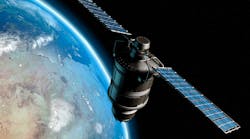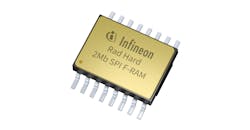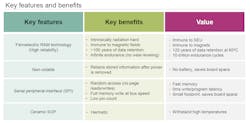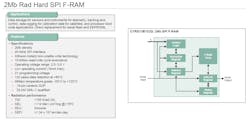Infineon Plays into Global Space Race with Rad-Hard FRAM
The space industry is booming, as the U.S. and other governments vie to lead the world in a new space race, and companies and startups push ahead with plans to deploy swarms of satellites into orbit around earth.
Companies such as SpaceX and Amazon are racing to roll out globe-spanning constellations of hundreds to thousands of relatively compact satellites to beam broadband anywhere in the world. Others are deploying even smaller remote-sensing satellites in orbits closer to earth, while new rocket ventures are reducing the cost of launching satellites into orbit, opening the door to new competition for dominance in space.
But as the next chapter of the space age takes shape, Infineon Technologies and others are increasingly betting on chips that can handle the hazards of space, one of the most hostile environments for electronics.
Infineon last month rolled out the first in a new family of radiation-hardened, serial-interface ferroelectric RAM (FRAM) for satellites and other spacecraft, with the durability lasting years—and even decades—in orbit.
Shot into Orbit
Reliability takes precedence in the space industry. The chips in satellites and other space-grade electronics must withstand harsh vibrations and shocks that can cause damage and even short circuits during launch.
These components also face major thermal-management challenges outside the earth's atmosphere. They have to be protected against wide temperature fluctuations that cut into how long they can survive in space.
But in terms of component reliability in space, the top challenge—by far—is the constant exposure to radiation.
In space, electronic components are bombarded by a wide range of particles that create electrical charges that can wreak havoc on hardware. Heavy doses of radiation over the long term—called the total ionizing dose (TID)—may permanently damage hardware and hurt the performance of the device over its lifespan. Damage due to radiation can lead to serious malfunctions or even catastrophic failure of the device.
Solar flares and other unpredictable incidents can also shoot particles directly into a device, altering data stored in memory or causing a sudden short circuit—called "latch-up"—that could lead to its destruction.
Under these conditions, off-the-shelf components will not last long before suffering a serious malfunction.
Space Qualifications
Helmut Puchner, VP Fellow of Aerospace and Defense at Infineon, said that as companies and governments rocket into space, demand for high-reliability, space-qualified memories such as Infineon’s 2-MB FRAM is rising.
“We now have a situation where we are building more computational infrastructure in space,” said Puchner. According to Infineon, customers are eyeing more advanced memories to support space-grade FPGAs and other high-performance processors used in satellites for real-time, onboard data processing.
Infineon said FRAM has unique physical properties that protect it against radiation that can alter the data stored in memory. The 2-MB FRAM is highly robust and radiation-hardened for up to 150 kilorads (krad).
Puchner said that this is more than enough in satellites in geosynchronous orbits more than 20,000 miles above the planet’s surface, where electronics are exposed to around 30 to 100 krads of radiation. “If you have a component with more than 100 krad, you can cover about 98% of all applications."
He explained that Infineon’s FRAM is nonvolatile and supports more than 120 years of data retention in the event of a power failure. When the system recovers power, it can restart from exactly where it was before it shut down.
According to Infineon, the rad-hard FRAM could serve as a replacement for serial NOR flash and EEPROM memories that are less tolerant of radiation and consume more power from the satellite’s solar panels. The 2-MB FRAMs can be used for continuous, mission-critical data logging and backup and data storage for telemetry, command, and control. The chips can also be used to store boot code for Arm-based microcontrollers and space-grade FPGAs.
Unlimited Endurance
A wave of “new space” companies are spending billions of dollars to send thousands of satellites that resemble refrigerators into the lower reaches of orbit, the area spanning up to 1,200 miles above Earth.
But many of these companies are using automotive-grade parts to assemble the satellites, said Puchner. These parts are designed to withstand intense vibration and wide temperature variations and, as a result, are robust enough to be used in low-Earth-orbiting satellites, which are partly protected from radiation by the Earth’s atmosphere. These types of satellites are only designed to last for around half a decade.
While satellites relatively close to Earth only stay up for several years, traditional satellites used in areas such as navigation, communications, and defense must be hardened against radiation and other space hazards for 15 years or more. Infineon said its latest family of FRAM is ideal for these satellites, which can be as large as a bus, cost hundreds of millions of dollars, and are typically placed in geosynchronous orbits.
“The 'new space' constellations assume some attrition rate,” said Puchner. “The 2-MB FRAM is more targeted at Class-A and higher-level government missions that need the reliability and quality to survive more than a couple of years.”
The company has rigorously tested or “qualified” the new family of space-bound FRAMs against a broad range of aerospace industry standards, including DLAM QML-V, the highest standard for electronics in Earth's orbit.
One of the unique advantages of FRAM is it effectively has unlimited endurance. Infineon's FRAM has the ability to handle 10 trillion read/write cycles, allowing data to be logged continuously throughout the useful life of the satellite.
Infineon’s FRAM can also be used in avionics and other systems subject to military temperature grades of –55 to 125°C. The memory is available in a 16-pin, 10- × 8-mm SOP ceramic package that contributes to its robustness.
The FRAM uses the industry-standard SPI interface to reduce pin counts and allow for smaller footprints. Serial protocols are increasingly used in satellites, many of which leverage SPI-capable space-grade processors.
Infineon said the 2-MB FRAM is also suited for space because it’s low power: The FRAM has a maximum of 10 mA of operating current, programming voltage of 2.0 V, and operating voltage range of 2.0 to 3.6 V.
From the Ground Up
Infineon has for decades been a major player in space-grade chips. In fact, it supplied many of the mission-critical, rad-hard power electronics in the James Webb Space Telescope, which will succeed the Hubble Space Telescope as NASA’s premier space observatory for the next decade. The company also offers a wide range of high-reliability SRAM, FRAM, and NOR flash memories for industrial, automotive, and aerospace applications.
To serve the space industry, Infineon usually takes its automotive- or industrial-grade memories and adds process and packaging improvements to harden them against radiation and other perils in space.
But as the space market grows, it is stepping up plans to roll out chips specifically for space. Puchner said Infineon has rad-hard NOR flash memories, designed from the ground up for satellites, now in development.
"We look forward to bringing more industry-firsts to the space market," Puchner said.





